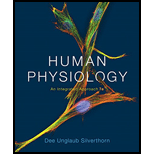
EBK HUMAN PHYSIOLOGY
7th Edition
ISBN: 9780133983401
Author: Silverthorn
Publisher: YUZU
expand_more
expand_more
format_list_bulleted
Concept explainers
Question
Chapter 9, Problem 25RQ
Summary Introduction
To determine: The appropriate word in the place of a question mark.
Introduction: The central nervous system in vertebrates is divided into the brain and the spinal cord. The central nervous system contains neural tissue layers near a central cavity which is fluid-filled and lined with epithelium in all vertebrates. The central nervous system also consists of supportive glial cells as well as neurons.
Expert Solution & Answer
Want to see the full answer?
Check out a sample textbook solution
Students have asked these similar questions
What is the structure and function of Eukaryotic cells, including their organelles? How are Eukaryotic cells different than Prokaryotic cells, in terms of evolution which form of the cell might have came first? How do Eukaryotic cells become malignant (cancerous)?
What are the roles of DNA and proteins inside of the cell? What are the building blocks or molecular components of the DNA and proteins? How are proteins produced within the cell? What connection is there between DNA, proteins, and the cell cycle? What is the relationship between DNA, proteins, and Cancer?
Why cells go through various types of cell division and how eukaryotic cells control cell growth through the cell cycle control system?
Chapter 9 Solutions
EBK HUMAN PHYSIOLOGY
Ch. 9 - Prob. 1CCCh. 9 - Name the four kinds of glial cells found in the...Ch. 9 - Prob. 3CCCh. 9 - Prob. 4CCCh. 9 - Prob. 5CCCh. 9 - Prob. 6CCCh. 9 - Prob. 7CCCh. 9 - Prob. 8CCCh. 9 - Prob. 9CCCh. 9 - In the late 1800s, the scientist Paul Ehrlich...
Ch. 9 - Prob. 11CCCh. 9 - Prob. 12CCCh. 9 - Prob. 13CCCh. 9 - Are the following white matter or gray matter? (a)...Ch. 9 - Using the information from Table 9.1, describe the...Ch. 9 - In anatomical directional terminology, the...Ch. 9 - Prob. 17CCCh. 9 - Prob. 18CCCh. 9 - Prob. 19CCCh. 9 - Prob. 20CCCh. 9 - Prob. 21CCCh. 9 - Prob. 1RQCh. 9 - Prob. 2RQCh. 9 - Prob. 3RQCh. 9 - In vertebrates, the central nervous system is...Ch. 9 - Prob. 5RQCh. 9 - Prob. 6RQCh. 9 - Prob. 7RQCh. 9 - Prob. 8RQCh. 9 - Prob. 9RQCh. 9 - Prob. 10RQCh. 9 - Prob. 11RQCh. 9 - What does cerebral lateralization refer to? What...Ch. 9 - Match each of the following areas with its...Ch. 9 - Name the 12 cranial nerves in numerical order and...Ch. 9 - Name and define the two major phases of sleep. How...Ch. 9 - List several homeostatic reflexes and behaviors...Ch. 9 - Prob. 17RQCh. 9 - What are the broad categories of learning? Define...Ch. 9 - Prob. 19RQCh. 9 - Prob. 20RQCh. 9 - Prob. 21RQCh. 9 - What are the three brain systems that regulate...Ch. 9 - Explain the role of Wernickes and Brocas areas in...Ch. 9 - Compare and contrast the following concepts: a....Ch. 9 - Prob. 25RQCh. 9 - Prob. 26RQCh. 9 - What properties do motivational states have in...Ch. 9 - Prob. 28RQCh. 9 - Mr. Andersen, a stroke patient, experiences...Ch. 9 - Prob. 30RQCh. 9 - Prob. 31RQCh. 9 - Prob. 32RQCh. 9 - Prob. 33RQ
Knowledge Booster
Learn more about
Need a deep-dive on the concept behind this application? Look no further. Learn more about this topic, biology and related others by exploring similar questions and additional content below.Similar questions
- In one paragraph show how atoms and they're structure are related to the structure of dna and proteins. Talk about what atoms are. what they're made of, why chemical bonding is important to DNA?arrow_forwardWhat are the structure and properties of atoms and chemical bonds (especially how they relate to DNA and proteins).arrow_forwardThe Sentinel Cell: Nature’s Answer to Cancer?arrow_forward
- Molecular Biology Question You are working to characterize a novel protein in mice. Analysis shows that high levels of the primary transcript that codes for this protein are found in tissue from the brain, muscle, liver, and pancreas. However, an antibody that recognizes the C-terminal portion of the protein indicates that the protein is present in brain, muscle, and liver, but not in the pancreas. What is the most likely explanation for this result?arrow_forwardMolecular Biology Explain/discuss how “slow stop” and “quick/fast stop” mutants wereused to identify different protein involved in DNA replication in E. coli.arrow_forwardMolecular Biology Question A gene that codes for a protein was removed from a eukaryotic cell and inserted into a prokaryotic cell. Although the gene was successfully transcribed and translated, it produced a different protein than it produced in the eukaryotic cell. What is the most likely explanation?arrow_forward
- Molecular Biology LIST three characteristics of origins of replicationarrow_forwardMolecular Biology Question Please help. Thank you For E coli DNA polymerase III, give the structure and function of the b-clamp sub-complex. Describe how the structure of this sub-complex is important for it’s function.arrow_forwardMolecular Biology LIST three characteristics of DNA Polymerasesarrow_forward
arrow_back_ios
SEE MORE QUESTIONS
arrow_forward_ios
Recommended textbooks for you
 Medical Terminology for Health Professions, Spira...Health & NutritionISBN:9781305634350Author:Ann Ehrlich, Carol L. Schroeder, Laura Ehrlich, Katrina A. SchroederPublisher:Cengage Learning
Medical Terminology for Health Professions, Spira...Health & NutritionISBN:9781305634350Author:Ann Ehrlich, Carol L. Schroeder, Laura Ehrlich, Katrina A. SchroederPublisher:Cengage Learning Principles Of Radiographic Imaging: An Art And A ...Health & NutritionISBN:9781337711067Author:Richard R. Carlton, Arlene M. Adler, Vesna BalacPublisher:Cengage Learning
Principles Of Radiographic Imaging: An Art And A ...Health & NutritionISBN:9781337711067Author:Richard R. Carlton, Arlene M. Adler, Vesna BalacPublisher:Cengage Learning Nutrition Through The Life CycleHealth & NutritionISBN:9781337919333Author:Brown, Judith E.Publisher:Cengage Learning,
Nutrition Through The Life CycleHealth & NutritionISBN:9781337919333Author:Brown, Judith E.Publisher:Cengage Learning,

Medical Terminology for Health Professions, Spira...
Health & Nutrition
ISBN:9781305634350
Author:Ann Ehrlich, Carol L. Schroeder, Laura Ehrlich, Katrina A. Schroeder
Publisher:Cengage Learning

Principles Of Radiographic Imaging: An Art And A ...
Health & Nutrition
ISBN:9781337711067
Author:Richard R. Carlton, Arlene M. Adler, Vesna Balac
Publisher:Cengage Learning


Nutrition Through The Life Cycle
Health & Nutrition
ISBN:9781337919333
Author:Brown, Judith E.
Publisher:Cengage Learning,


Bacterial Endospore Formation -Biology Pundit; Author: Biology Pundit;https://www.youtube.com/watch?v=6_sinRhE8zA;License: Standard YouTube License, CC-BY
Taxonomy of Bacteria: Identification and Classification; Author: Professor Dave Explains;https://www.youtube.com/watch?v=8IJRzcPC9wg;License: Standard YouTube License, CC-BY